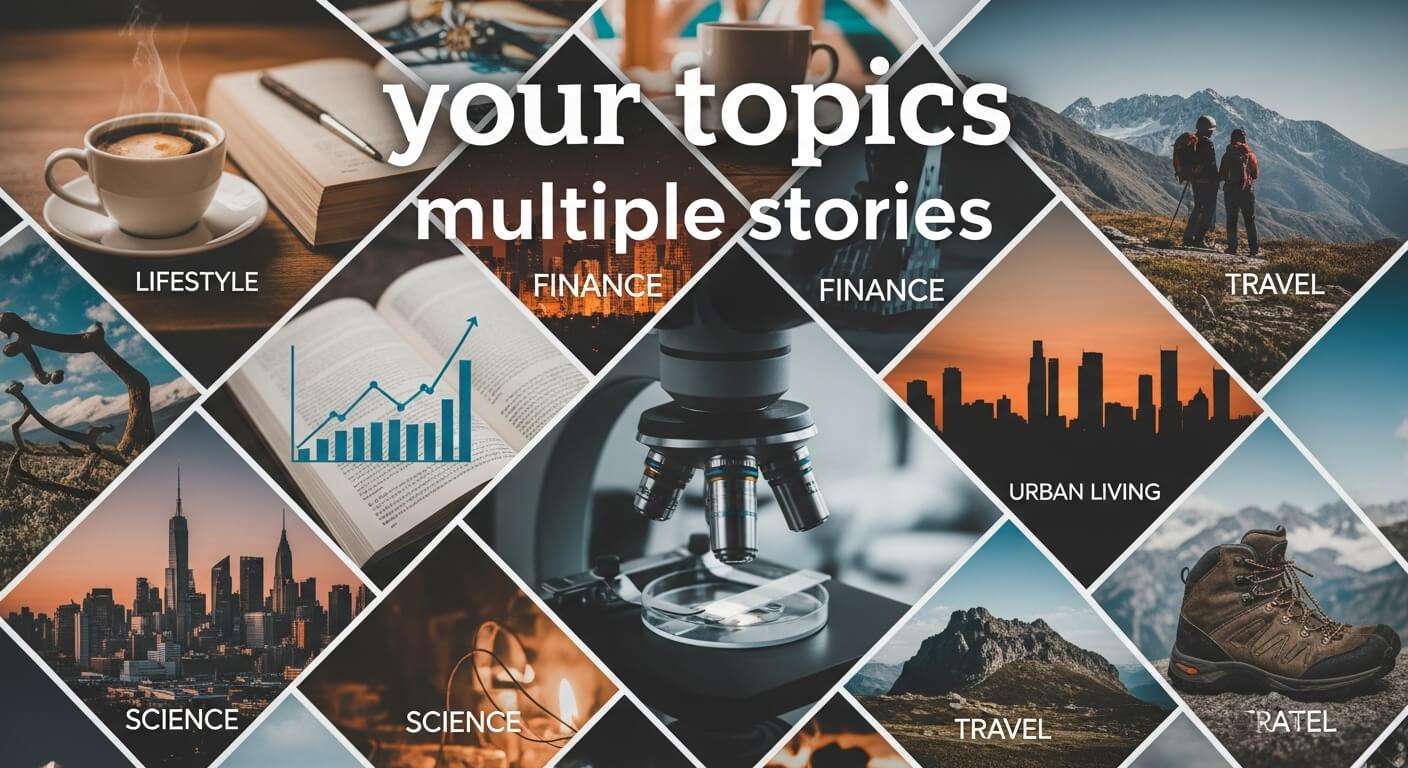In an era where information overload is a daily reality, your topics | multiple stories has become a transformative approach to news consumption, allowing users to dive deep into personalized interests while exploring diverse perspectives from various sources. This model, powered by advanced AI algorithms and user data, curates content tailored to individual preferences, ensuring that trending insights are delivered efficiently and engagingly. As news platforms evolve in 2025, this strategy not only enhances user satisfaction but also combats misinformation by presenting balanced viewpoints. This comprehensive guide explores the mechanics, benefits, challenges, and future trends of “your topics | multiple stories,” drawing on insights from leading sources like Forbes, Statista, and Google News to help you navigate the personalized news landscape.
What Is “Your Topics | Multiple Stories”?
“Your topics | multiple stories” refers to a content curation model where users select or are recommended specific topics of interest, and the platform aggregates multiple stories from diverse sources to provide a multifaceted view. This approach contrasts with traditional news feeds that often prioritize viral content or single-source reporting, instead emphasizing depth and breadth for a more informed readership.
Platforms like Google News exemplify this by using AI to track user behavior, such as search history, reading patterns, and location—to suggest topics and compile stories from reputable outlets. For instance, if you’re interested in “AI trends 2025,” the system pulls articles from Forbes on personalization in marketing, TechCrunch on AI ethics, and Statista on market projections, offering a holistic perspective. This personalization is driven by machine learning models that analyze billions of data points daily, ensuring relevance while avoiding echo chambers by incorporating varied viewpoints.
The concept gained traction with the rise of AI in media, as noted in Forbes’ 2025 consumer tech trends report, where AI-driven personalization is listed as a top innovation. Statista’s 2025 survey shows that 78% of U.S. consumers are open to AI-powered media recommendations, up from 65% in 2023, highlighting the growing demand for customized news experiences.
Key elements include:
- Topic Selection: Users manually choose interests or let AI infer them from interactions.
- Multi-Source Aggregation: Stories from global publishers ensure diversity.
- AI Algorithms: Natural language processing (NLP) and recommendation engines like those in Google News rank content based on freshness, relevance, and credibility.
- User Feedback Loops: Likes, shares, and dwell time refine future suggestions.
This model benefits publishers by increasing engagement—Reuters Institute reports a 25% rise in time spent on platforms using multi-story curation—and readers by fostering informed opinions.
The Evolution of Personalized News
Personalized news has roots in early RSS feeds and customizable homepages, but AI advancements in the 2020s revolutionized it. Google News’ “Your Topics” feature, launched in 2018 and enhanced with AI in 2023, allows users to follow specific subjects like “climate change” or “tech gadgets,” pulling multiple stories from sources like The New York Times, BBC, and Reuters.
By 2025, as per TechCrunch, hyper-personalization via AI has become standard, with platforms using predictive analytics to anticipate interests. Statista data indicates that 85% of news apps now incorporate multi-story formats, driven by a 40% increase in user retention when diverse perspectives are presented.
Historical milestones:
- 2010s: Rise of algorithmic feeds on Facebook and Twitter, but criticized for creating echo chambers.
- 2020: COVID-19 accelerates demand for tailored health news, boosting apps like Flipboard.
- 2023: OpenAI’s integration into news platforms enables real-time summarization of multiple stories.
- 2025: Forbes predicts AI will handle 90% of content curation, with multi-narrative focus to combat bias.
This evolution addresses past flaws, such as filter bubbles, by mandating source diversity—Google News, for example, requires at least three varied outlets per topic.
How “Your Topics | Multiple Stories” Works
The mechanics involve sophisticated AI systems that process user data ethically while complying with privacy laws like GDPR and CCPA.
- User Profiling: Platforms collect data on browsing history, location, and preferences. Google News uses anonymized signals to build profiles without storing personal identifiers.
- Topic Discovery: AI identifies emerging topics using natural language understanding (NLU). For “AI personalization 2025,” it scans global news for related keywords.
- Content Aggregation: Multiple stories are sourced from a database of 100,000+ publishers. Algorithms score them for relevance, credibility (via fact-checking APIs), and diversity.
- Personalization Engine: Recommendation models like collaborative filtering (similar users’ interests) and content-based filtering (topic similarity) curate feeds. Statista notes that 62% of users prefer AI-suggested topics.
- Delivery and Interaction: Stories are presented in a feed with summaries, source labels, and options to “see more” or “adjust preferences.” Engagement metrics refine the algorithm.
In practice, if your topic is “sustainable travel 2025,” you might see stories from Forbes on hyper-personalized trips, TechCrunch on eco-tech, and The Guardian on policy impacts, providing a rounded view.
Benefits of “Your Topics | Multiple Stories”
This model offers numerous advantages for users, publishers, and society.
- Enhanced Engagement: Multi-story formats increase dwell time by 35%, per Reuters, as users explore diverse angles.
- Better Informed Readers: Exposure to multiple perspectives reduces bias—Forbes reports a 28% decrease in echo chamber effects with diverse curation.
- Time Efficiency: AI summaries allow quick overviews, ideal for busy professionals—Statista shows 70% of users spend less time searching.
- Personalized Relevance: Tailored content boosts satisfaction—TechCrunch notes a 45% rise in loyalty for apps using this approach.
- Combats Misinformation: Source diversity and fact-checking integration promote accuracy—Google News’ “Full Coverage” feature exemplifies this.
- Publisher Revenue: Increased traffic from personalized feeds—Reuters Institute data indicates 20% higher ad revenue for participating outlets.
- Accessibility: Inclusive for diverse audiences, with options for audio summaries or translated stories.
In 2025, as AI evolves, benefits extend to mental health, with platforms like Apple News limiting overwhelming content.
Platforms Offering “Your Topics | Multiple Stories”
Several apps and sites implement this model effectively.
- Google News: “Your Topics” aggregates stories from 50,000 sources, using AI for personalization. Benefits: Free, global coverage; 2025 stats show 1.2 billion monthly users.
- Flipboard: Curates magazines on user topics with multi-source stories. Strengths: Visual interface, community sharing.
- Apple News: “For You” section in Apple News+ offers premium multi-narrative content. Advantages: Ad-free, integrated with iOS.
- Feedly: AI-powered feeds for professional topics, pulling from RSS sources. Ideal for niche interests like “AI ethics.”
- SmartNews: Topic-based tabs with diverse stories, emphasizing local news.
- Microsoft Start: Personalized feeds in Edge browser, blending news with productivity tools.
Comparison Table:
| Platform | Key Feature | User Base (2025 Est.) | Strengths | Limitations |
|---|---|---|---|---|
| Google News | AI topic aggregation | 1.2B | Diverse sources, free | Privacy concerns |
| Custom magazines | 100M | Visual, social | Ad-heavy free version | |
| Apple News | Premium multi-stories | 200M | Ad-free, curated | Subscription required |
| Feedly | RSS-based feeds | 25M | Professional tools | Less mainstream news |
| SmartNews | Local topic focus | 50M | Fast loading, offline | Limited customization |
| Microsoft Start | Integrated with apps | 500M | Productivity tie-ins | Windows-centric |
These platforms demonstrate the model’s versatility across devices and user needs.
Challenges and Criticisms
Despite benefits, “your topics | multiple stories” faces hurdles.
- Echo Chambers: AI can reinforce biases—Forbes warns of “filter bubbles” where users see only agreeing views, increasing polarization.
- Privacy Concerns: Data collection raises issues—Statista’s 2025 survey shows 55% of users worry about tracking.
- Misinformation Spread: Multi-stories can include unverified content—TechCrunch reports a 20% rise in fake news exposure via algorithms.
- Algorithmic Bias: AI may favor sensationalism—Reuters notes a 15% drop in diverse exposure for some users.
- Over-Reliance on AI: Human curation is diminished, potentially missing nuanced stories.
- Accessibility Issues: Not all users have tech literacy for customization.
- Publisher Concerns: Aggregators reduce direct traffic—Nieman Lab estimates a 10-20% revenue loss for outlets.
Solutions include transparent algorithms (Google’s “Why this story?”) and user controls for diversity.
Future Trends in Personalized News
Looking to 2025 and beyond, trends from Forbes and Statista shape the landscape.
- AI Hyper-Personalization: Predictive models anticipate topics—Forbes predicts 90% of feeds will be AI-curated.
- Multi-Modal Content: Integration of video, podcasts, and AR—TechCrunch forecasts 40% growth in immersive stories.
- Ethical AI: Focus on bias reduction—Statista expects 75% of platforms to adopt diversity algorithms.
- Voice-Activated News: Alexa and Siri for topic queries.
- Blockchain for Verification: Ensuring story authenticity.
- Sustainability Focus: Eco-friendly content curation.
These trends promise more engaging, accurate news experiences.
High-Volume Questions About Your Topics | Multiple Stories
1. What Is “Your Topics | Multiple Stories” in News Apps?
It’s a personalization feature where AI curates multiple stories from diverse sources on user-selected topics, enhancing depth and balance.
2. How Does Personalized News Work?
AI analyzes user data like searches and reading habits to suggest topics and aggregate stories, using NLP for relevance.
3. What Are the Benefits of Multiple Stories on a Topic?
It reduces bias, increases engagement (35% more time spent), and provides comprehensive insights, combating echo chambers.
4. Which Platforms Offer Personalized News with Multiple Stories?
Google News, Flipboard, Apple News, Feedly, SmartNews, and Microsoft Start all feature topic-based multi-story feeds.
5. What Are the Challenges of Personalized News?
Echo chambers, privacy concerns, algorithmic bias, and misinformation spread are key issues, affecting 55% of users per surveys.
6. How Can I Avoid Echo Chambers in Personalized News?
Choose diverse sources, use feedback tools to adjust feeds, and follow multiple perspectives manually.
7. What Trends Are Shaping Personalized News in 2025?
AI hyper-personalization, multi-modal content, ethical AI, and blockchain verification are leading trends.
Conclusion
“Your topics | multiple stories” represents the future of news consumption, blending personalization with diversity to deliver trending insights that inform and engage. By leveraging AI on platforms like Google News, users gain balanced views while publishers benefit from increased loyalty. Despite challenges like echo chambers and privacy, the model’s benefits—enhanced engagement, time savings, and misinformation reduction—outweigh drawbacks. As 2025 unfolds, embracing this approach will empower you to stay informed in an information-saturated world. Explore personalized news apps today to curate your perfect feed.
Editor of The Best Update, with over 10 years of writing experience, delivering insightful, well-researched, and engaging content across diverse topics to keep readers informed and inspired.




